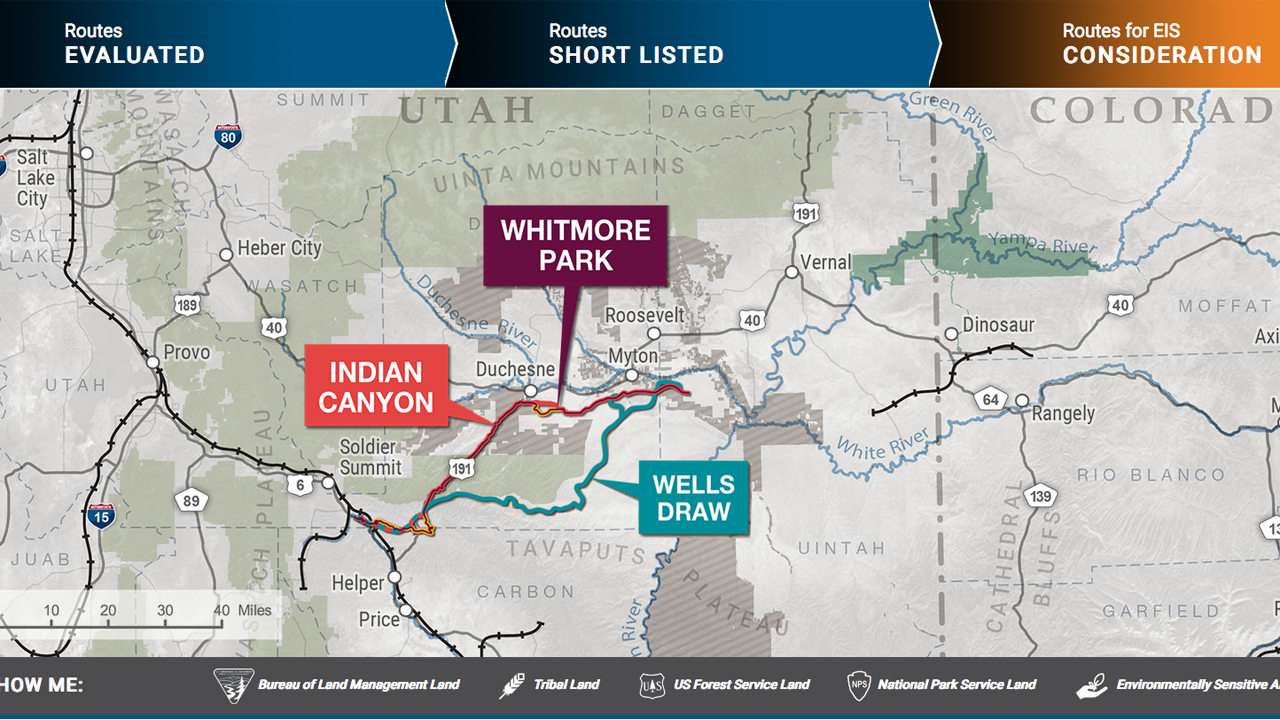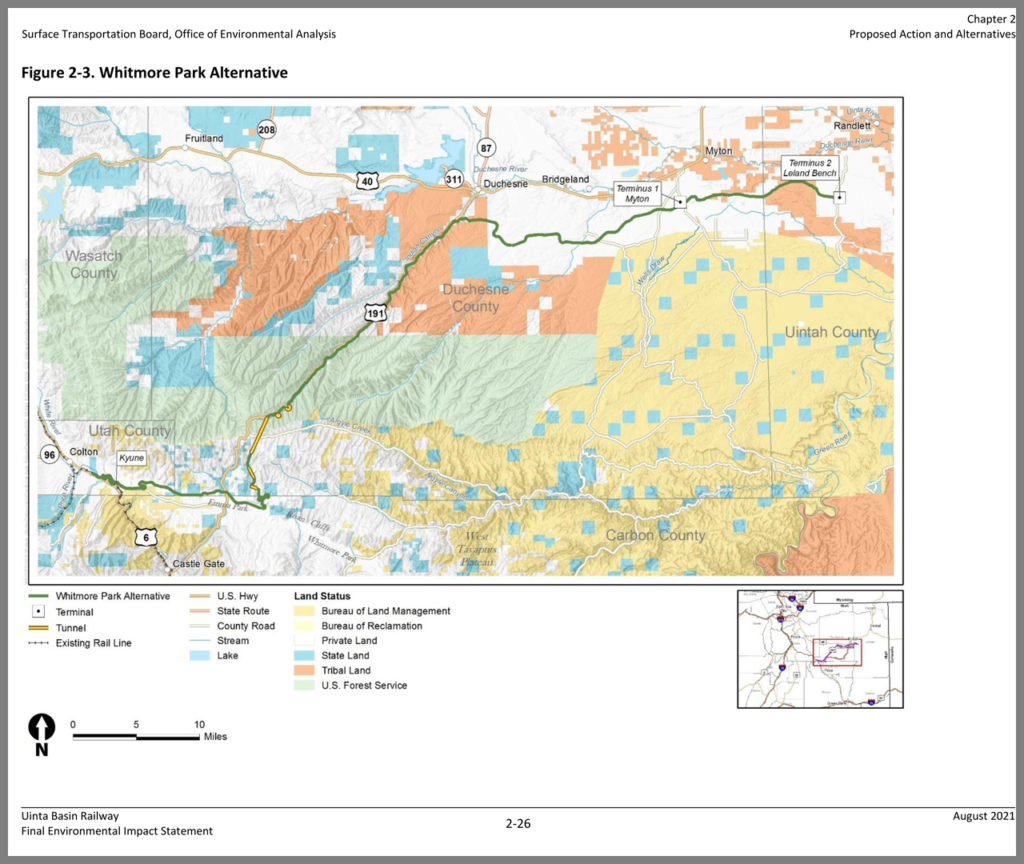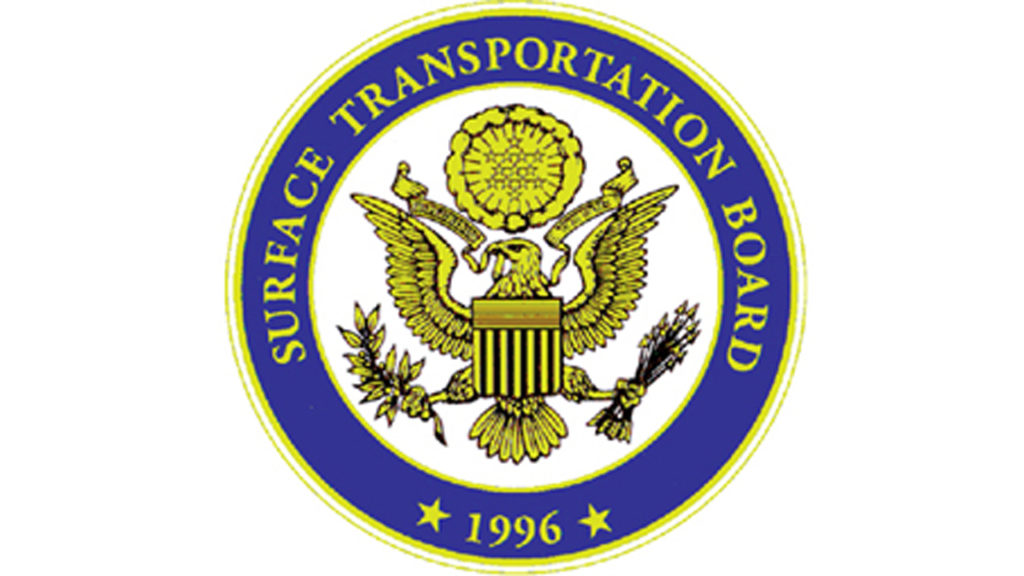
Report: STB Approval of Uinta Basin Railway Challenged
Written by Marybeth Luczak, Executive Editor
STB on Dec. 15, 2021 approved the Uinta Basin Railway. Its Office of Environmental Analysis last summer issued a Final Environmental Impact Statement for the project, identifying the 88-mile Whitmore Park Alternative as the environmentally preferred route, one of three analyzed.
The Surface Transportation Board’s (STB) “inadequate” assessments of the Uinta Basin Railway project’s climate, public health and safety impacts undermine its approval of the project under the Interstate Commerce Commission Termination Act, according to a Colorado County and environmental groups, Law360 reports.
STB on Dec. 15, 2021, approved the construction and operation of the Uinta Basin Railway, which is slated to link oil and gas resources in Utah and Colorado to the national rail network; STB Chairman Martin Oberman was the sole dissenter.
In August 2021, STB’s Office of Environmental Analysis (OEA) issued a Final Environmental Impact Statement (EIS) for the project, identifying the 88-mile Whitmore Park Alternative as the environmentally preferred route, one of three analyzed. It would extend from two terminus points in the Uinta Basin in northeastern Utah near Myton and Leland Bench to a connection with the existing Union Pacific Provo Subdivision near Kyune (see map below). The route includes five tunnels, totaling 5.7 miles. The estimated construction cost is approximately $1.35 billion.

The project “would include construction on sensitive lands, including in the Ashley National Forest where roughly 12 miles of development would include five bridges and three tunnels even though that area is protected by the Roadless Area Conservation Rule,” Law360 reported. “The broader project would also affect hundreds of streams and thousands of acres of wildlife habitat.”
Eagle County, Colo., and the Center For Biological Diversity, Sierra Club, and other environmental groups are now challenging STB’s project approval in the U.S. Court of Appeals for the D.C. Circuit. According to the environmental groups’ Aug. 18 opening brief, “while the environmental impact statement disclosed that the rail project would be capable of hauling up to 350,000 barrels of oil a day, it failed to review the project’s reasonably foreseeable indirect effects from the significant boost in oil production from the Uinta Basin in Utah,” Law360 summarized. “The project would encourage downstream pollution and increased greenhouse gas emissions. …”
“‘This failure also put a thumb on the scale for the project, because the EIS disclosed the economic benefits of increased oil production, but not the corresponding harms, or minimized them as cumulative impacts not attributable to the project,’ the environmental groups said in their brief,” Law360 reported.
The Colorado county said in its brief that the STB “refused to engage in a balanced analysis of the environmental impact and transportation merits, including consideration of all the identified environmental impacts, financial questions, and public health and safety risks documented in the record,” according to Law360. “The Board’s decision to exempt the railway was arbitrary and violated the ICCTA [ICC Termination Act of 1995].”
Center For Biological Diversity senior attorney Wendy Park told Law360 that the STB “ignored that the railway will expand dirty drilling in the Uinta Basin, worsen toxic pollution in Gulf Coast communities, and unleash 53 million tons of climate pollution per year. This blinkered approach violated the law and shunted aside frontline communities that will be harmed the most.”
Park as well as Edward B. Zukoski of the Center For Biological Diversity are representing the environmental groups, according to Law360; Eagle County attorney Bryan R. Treu, and Kaplan Kirsch & Rockwell LLP’s Nathaniel H. Hunt, Robert W. Randall and Christian L. Alexander represent Eagle County.
Background
In its final approval decision issued Dec. 15, 2021, STB wrote: “The Board recognizes that, as with most other rail construction projects, the construction and operation of this Line is likely to produce unavoidable environmental impacts. But the Board also finds that the construction and operation of the Environmentally Preferred Whitmore Park Alternative, with the extensive mitigation conditions imposed, will minimize those impacts to the extent practicable.”
Construction and operation of line, STB said, “will have substantial transportation and economic benefits. … [T]he Line will bring rail service to an area of Utah that does not currently have service, provide shippers that must now rely on trucks another shipping option, and create jobs. … Rail service will eliminate longstanding transportation constraints. The availability of a more cost-effective rail transportation option could also support the diversification of local economies in the Basin, which could support additional employment and expand the regional economy. … Moreover, the Board notes the Ute Indian Tribe’s support of the project and the benefits that the Tribe has stated that it will provide. … The environmental impacts identified in the Draft and Final EIS have been sufficiently mitigated so that they do not outweigh the Line’s transportation benefits. …”

STB Chairman Oberman disagreed with the decision, writing in his dissent of concerns “regarding the Line’s financial viability given the increasingly uncertain global market for crude oil, and the likelihood that it would be the public—and not private investors—who would bear the cost of constructing an ultimately unprofitable rail project. These concerns have grown over the last year, as the world economy has accelerated its transition away from use of the internal combustion engine and corresponding need for crude oil. Ever increasing doubt about the future market for oil undermines the project’s transportation merits and counsels against an exemption.”
He also wrote that “the Line’s environmental impacts significantly outweigh its transportation merits. In my view, it should be underscored that the Board has the power to deny construction approval based on weighing all of the environmental impacts that will arise from oil and gas development in the Basin, and the Board should consider those impacts as the reasonably foreseeable, indirect effects that they are, especially since the ‘entire purpose’ of this Line is to stimulate and support oil production in the Basin. Assessing these impacts solely within a cumulative impact analysis, as Today’s [Dec. 15] Decision does, badly understates their significance, and in particular the significance of downstream greenhouse gas emissions that will result from the combustion of oil moved over the Line. The critical question presented in this proceeding is whether the Line would serve the public interest given its centrality to oil development in the Basin and the broader and dire global warming crisis, as well as the very serious, significant, and unavoidable environmental impacts that Today’s Decision does in fact attribute to the project.
“Absent some particularized national need for increased oil from the Basin, of which there is none, I cannot support construction of the Line.”
In May 2022, AECOM, Skanska-Clyde Joint Venture and Obayashi Corporation landed the final engineering and construction contracts for the Uinta Basin Railway project, which is backed by the state of Utah’s Seven County Infrastructure Coalition. On May 29, 2020, the Coalition sought STB authority to build and operate the line. In September 2020, Drexel Hamilton Infrastructure Partners, LP and the Coalition executed an agreement to advance the line, whose operations would be handled by Fort Worth, Tex.-based Rio Grande Pacific Corporation (RGPC). The Ute Indian Tribe of the Uintah and Ouray Reservation is an equity partner in the railway.
Construction could begin as early as next year after the U.S. Forest Service dismissed an objection to a right-of-way the agency granted through Utah’s Ashley National Forest, Railway Age Engineering Editor and Railway Track & Structures Editor-in-Chief Bill Wilson reported last month. “In a letter, Deputy Regional Forester Deborah Oakeson said the decision on the right-of-way was sound.”
It would be the first major freight rail project built in the U.S. in the past 30 years.
Further Reading
Taking Measure of STB’s Oberman



